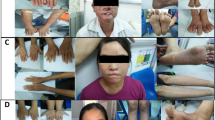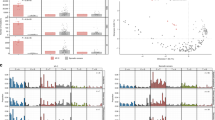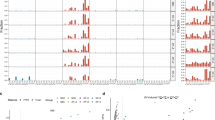Abstract
Xeroderma pigmentosum (XP) is a rare autosomal recessive disease of humans characterized by an accelerated chronic degeneration of sun–exposed areas of the body, including an elevated risk of developing cancers of the skin. We recently reported the isolation of a gene XPCC that complements the repair deficiency of cultured XP–C cells. Here we report the results of a characterization of XPCC at the nucleotide level in five XP–C cell lines. Each cell line exhibited a unique mutation that correlated well with the cellular DNA repair deficiency and the clinical severity of the disease. These results extend our previous observations and indicate that defects in XPCC cause Xeroderma pigmentosum group C.
This is a preview of subscription content, access via your institution
Access options
Subscribe to this journal
Receive 12 print issues and online access
$209.00 per year
only $17.42 per issue
Buy this article
- Purchase on Springer Link
- Instant access to full article PDF
Prices may be subject to local taxes which are calculated during checkout
Similar content being viewed by others
References
Robbins, J.H., Kraemer, K.H., Lutzner, M.A., Festoff, B.W. & Coon, H.G. Xeroderma pigmentosum: an inherited disease with sun sensitivity, multiple cutaneous neoplasms, and abnormal DNA repair. Ann. intern. Med. 80, 221–248 (1974).
Cleaver, J.E. & Kraemer, K.H. Xeroderma pigmentosum. in The Metabolic Basis of Inherited Disease 6th edn (eds Scriver, C.R. et al.) 2949–2971 (McGraw-Hill, New York, 1989).
Andrews, A.D., Barrett, S.F. & Robbins, J.H. Xeroderma pigmentosum neurological abnormalities correlate with colony-forming ability after ultraviolet radiation. Proc. natn. Acad. Sci. U.S.A. 75, 1984–1988 (1978).
Cleaver, J.E. Defective repair replication of DNA in xeroderma pigmentosum. Nature 218, 652–656 (1968).
Tanaka, K., Satokata, I., Ogita, Z., Uchida, T. & Okada, Y. Molecular cloning of a mouse DNA repair gene that complements the defect of group-A xeroderma pigmentosum. Proc. natn. Acad. Sci. U.S.A. 86, 5512–5516 (1989).
Weeda, G. et al. Molecular cloning and biological characterization of the human excision repair gene ERCC-3. Molec. cell. Biol. 10, 2570–2581 (1990).
Legerski, R.J. & Peterson, C.A. Expression cloning of a human DNA repair gene involved in xeroderma pigmentosum group C. Nature 359, 70–73 (1992).
Weber, C.A., Salazar, E.P., Stewart, S.A. & Thompson, L.H. Molecular cloning and biological characterization of a human gene, ERCC-2, which corrects the nucleotide excision repair defect in CHO UV5 cells. Molec. cell. Biol. 8, 1137–1146 (1988).
Saiki, R. et al. Enzymatic amplification of β-globin genomic sequences and restriction site analysis for diagnosis of sickle cell anemia. Science 230, 1350–1353 (1985).
Kremer, E.J. et al. Mapping of DNA instability at the fragile X to a trinucleotide repeat sequence p(CCG)n . Science 252, 1711–1714 (1991).
Fu, Y.H. et al. Variation of the CGG repeat at the fragile X site results in genetic instability: resolution of the Sherman paradox. Cell 67, 1047–1058 (1991).
Brook, J.D. et al. Molecular basis of myotonic dystrophy: expansion of a trinucleotide (CTG) repeat at the 3′ end of a transcript encoding a protein kinase family member. Cell 68, 799–808 (1992).
Mahadevan, M. et al. Myotonic dystrophy mutation: an unstable CTG repeat in the 3′ untranslated region of the gene. Science 255, 1253–1255 (1992).
Fu, Y.H. et al. An unstable triplet repeat in a gene related to myotonic dystrophy. Science 255, 1256–1258 (1992).
Robbins, J.H. Significance of repair of human DNA: evidence from studies of xeroderma pigmentosum. J. natn. Cancer Inst. 61, 645–656 (1978).
Daya-Grosjean, L., James, M.R., Drougard, C. & Sarasin, A. An immortalized xeroderma pigmentosum, group C, cell line which replicates SV40 shuttle vectors. Mut Res. 183, 185–196 (1987).
Wallace, M.R. et al. A de novo Alu insertion results in neurofibromatosis type 1. Nature 353, 864–866 (1991).
Dombroski, B.A., Mathias, S.L., Nanthakumar, E., Scott, A.F. & Kazazian, H.H. Jr., Isolation of an active human transposable element. Science 254, 1805–1808 (1991).
Mashima, Y. et al. Nonsense-codon mutations of the ornithine aminotransferase gene with decreased levels of mutant mRNA in gyrate atrophy. Am. J. hum. Genet. 51, 81–91 (1992).
Peterson, C.A. & Legerski, R.J. High-frequency transformation of human repair-deficient cell lines by an Epstein–Barr virus-based cDNA expression vector. Gene 107, 279–284 (1991).
Author information
Authors and Affiliations
Rights and permissions
About this article
Cite this article
Li, L., Bales, E., Peterson, C. et al. Characterization of molecular defects in xeroderma pigmentosum group C. Nat Genet 5, 413–417 (1993). https://doi.org/10.1038/ng1293-413
Received:
Accepted:
Issue Date:
DOI: https://doi.org/10.1038/ng1293-413
This article is cited by
-
Global Contributions to the Understanding of DNA Repair and Skin Cancer
Journal of Investigative Dermatology (2014)
-
c.1643_1644delTG XPC mutation is more frequent in Moroccan patients with xeroderma pigmentosum
Archives of Dermatological Research (2013)
-
The influence of DNA repair on neurological degeneration, cachexia, skin cancer and internal neoplasms: autopsy report of four xeroderma pigmentosum patients (XP-A, XP-C and XP-D)
Acta Neuropathologica Communications (2013)
-
Functional assays to determine the significance of two common XPC 3'UTR variants found in bladder cancer patients
BMC Medical Genetics (2011)
-
A Prevalent Mutation with Founder Effect in Xeroderma Pigmentosum Group C from North Africa
Journal of Investigative Dermatology (2010)



